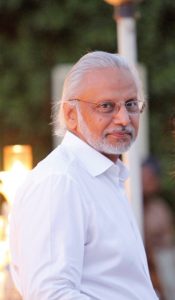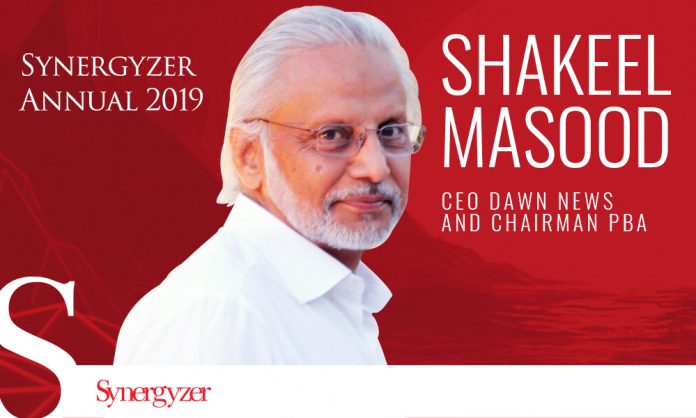As originally published in Synergyzer Annual 2019

Shakeel Masud, CEO – Dawn News & Chairman PBA, highlights how the media industry is under pressure due to to the government’s inability to release payments in billions owed to media houses and the issue of flight of capital from the Pakistani ecosystem.
Synergyzer: How have the past couple of years been for the industry in your opinion?
Shakeel Masud: The TV industry has been witnessing an unprecedented decrease in advertising revenue for the past couple of years, making the survival difficult for TV channels. You can gauge from the fact that the advertising spend allocated to broadcast media will decline to around Rs. 35 billion in 2018-2019 from Rs. 43 billion in 2017.
Synergyzer: What are the reasons?
Shakeel: 1) The sudden US Dollar escalation to Rs.138 against the Pakistani Rupee. 2) The federal and provincial governments, combined, used to spend around Rs. 5 to 6 billion on advertising annually, which is now almost non-existent since July 2018. 3) Due to the ongoing political and economic uncertainty as well as slowdown, the corporate sector has cut down on advertising. 4) The real estate sector has also reduced advertising due to prevailing uncertainty in that sector. 5) The share of digital is continuously increasing in our advertising pie, which itself is shrinking, on the other hand. According to market estimates, advertising spend on digital in Pakistan increased from Rs. 2.5 million in 2017 to Rs. 7 billion in 2018 and is expected to go up to Rs. 12 billion in 2019. Also, budgets are being allocated to digital by reducing those of TV and other mediums.
All this landed the TV industry in its current crisis.
Synergyzer: We know that media in Pakistan runs on advertising, and the government also has a share in keeping the media industry afloat. Has PBA raised the issue with the government?
Shakeel: Yes. You see, there are two aspects to the issue. One, as I mentioned earlier, is that the government has stopped advertising on television. Two, the government has not cleared the dues of TV and print media which are around Rs. 8 billion. This obviously affects our cash flows, leading to the perception that the government deliberately wants the media industry to be in a crisis.
To resolve these issues, it is important for the government to communicate their development plans, create investor and public confidence and generate positive sentiment. The Prime Minister himself is keen to communicate the government’s positive narrative to the masses, but there seems to be some confusion in the ranks below him.
Major beneficiaries of this growth are international platforms, which take almost 60% of the generated revenue.
Synergyzer: How is advertising done on digital platforms affecting the media economy in general?
Shakeel: As I mentioned earlier, the digital spend is expected to increase from Rs. 7 billion to Rs. 12 billion in 2019. Yet, the major beneficiaries of this growth are international platforms, which take almost 60% of the generated revenue. They are able to generate this due to their high audience volume and more targeted exposure. This allows them to give very low advertising tariffs, thus making them the go-to choice of advertisers whether local or international. This is resulting in flight of capital from our ecosystem, largely unregulated and untaxed, which needs to be addressed by our lawmakers and publishers.
Synergyzer: Has PBA addressed this issue through its platform?
Shakeel: We are working on it. At the moment, digital media does not come under the PBA aegis. Yet, we are working to bring it under broadcast media because digital and television are synced and close to each other. It is a huge amount of money, going out of our economy, so I believe our government will eventually start thinking about it and will rectify the practice through tax regulations etc.
Synergyzer: How do you see the digital technology impacting the TV sector in the future?
Shakeel: Currently, content consumption is through television channels and TV screens. In the next 4 to 5 years, it will shift to multiple screens. The television set will not change nor will content production cease, but the way you consume content might evolve. So in my opinion, TV channels need to re-think themselves as content producers and plan accordingly.
Digital media is growing exponentially, media houses and digital publishers need to figure out how to ride this relatively new wave.
Synergyzer: What will be the challenges and opportunities in 2019 for Pakistan’s media industry?
Shakeel: Currently, there are three major challenges in the industry. One, shrinking advertising spends; two, uncertainty leading to lack of economic activity and loss of investor confidence; and three, the rapid growth of digital media at the expense of other mediums. Pakistan’s economy has tremendous potential to grow and investors are willing to put in money, provided a positive atmosphere is created. Once the above issues are addressed, there will be an increased need for advertising and we have confidence that the media business will improve. To ensure this, the government needs to step up and give a clear signal that the economy is heading in the right direction and that they will do their bit to ensure that it keeps pace by encouraging foreign and local businesses to invest in the economy.
On the other hand, since digital media is growing exponentially, media houses and digital publishers need to figure out how to ride this relatively new wave. Also, the advertising pie needs to grow in size for the whole media industry, if it were to flourish.














